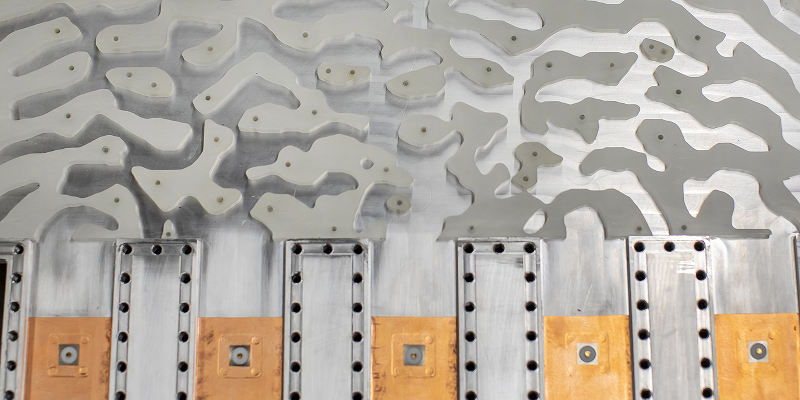If you have had trouble with ordinary calculus, you may not be pleased to hear about “photonic calculus” — a recent idea from [Nader Engheta] of the University of Pennsylvania. The idea is that materials with certain properties could manipulate an electromagnetic wave in a way to solve a specific mathematical equation. [Engheta] proposed this idea back in 2014 and recently announced that he and his team have a demonstration device that proves the concept. The analog computer is about twice the size of an airplane’s tray table and made of CNC-shaped polystyrene. It solves Fredholm integral equations of the second kind.
The analog computer uses microwaves for the input and the polystyrene acts as a dielectric full of air holes. The team likens its structure to that of Swiss cheese. The shape is generated through an inverse design process which builds the shapes from known solutions to the equations. That means a particular set of shapes will do one specific equation. The equation could, for example, model the sound volume in a concert hall. You can encode certain parameters in the input wave and the output would specify the volume at different locations. However, a change to the actual equation would require a new set of plastic pieces.
The computation is very fast. Using microwaves, the answer comes out in a few hundred nanoseconds — a speed a conventional computer could not readily match. The team hopes to scale the system to use light which will speed the computation into the picosecond range. Creating a new optical analog computer could be similar to how we burn a CD or DVD today.
Analog computers predate digital ones by a lot. We really want to build one like [Bill Schweber’s]. Then again, we wouldn’t mind finding a Donner 3500 at a hamfest, either.
















Like soviet integrator -analog- run on water
https://www.smithsonianmag.com/smart-news/computer-1949-runs-water-180953482/
https://en.wikipedia.org/wiki/Water_integrator
Then it’s like cheese analogue?
https://en.wikipedia.org/wiki/Cheese_analogue
“twice the size of an airplane’s tray table”. Really, now? How does the size compare to something more esoteric and unfamiliar to most readers, like an iPad or a stack of A4 paper?
Still more meaningful than inches to my European mind :)
Let the flame begin!
Even better than inches:
https://www.youtube.com/watch?v=-scs_yF59YE
He could have expressed it in standard american football fields, a unit so often used it would deserve to be SI.
It seems to me that, though the calculation is near-as-dammit instant, actually setting up the apparatus is an extremely protracted business. The linked article uses the example of simulating the acoustics of a concert hall. The “kernel” (a function included in the integral) is expressed by the shape of the microwave baffles, and if you try to model a different concert hall you need a new kernel and so a new set of baffles. By the time you had created them and spent nanoseconds calculating the results, a digital computer might have come up with the answer. Also, every time the problem changes, you are left with physical waste in the form of unwanted baffles.
Exactly. Its a bit like simulating the acoustics of a concert hall by using a concert hall as a Kernel and seeing what happens when you put sounds waves into it. I thought it looked a bit gimmicky (‘photonic calculus’ ?) and when I saw it was published in ‘Science’ that just sealed it.
This could still have applications though. When I read more about it, it really sounds not unlike another very common analog device still widely used, the ring laser gyro. A closed system, carefully designed and calibrated, to allow rapid calculation of a very specific problem. It’s not a general purpose computer, it’s more of a calculator in the same vein as a slide rule. I’m not sure they have proven a good use case for it, but it might have one.
There are plenty of equations that have very broad applications though. Look at how graphics accelerators started as chips that just contain lots of units that can perform vector/matrix multiplications really fast in parallel. Now imagine that, but instead of multiplication they return the solution for some class of differential equations, and poof you have a versatile physics accelerator, and even more so if you’ve got a chip that has units on it tailored for a handful of different equations! The way I see it, this is a potential breakthrough development in photonic computing.
Think of it like an ASIC or a hardware accelerator. There are plenty of applications of running a single algorithm repeatedly like crypto (cracking or currency mining) or signal analysis. Think this could be used for something like AES?
I could see this being used in the making of PCBs, integrating DRM into things in a hard to duplicate way.
And … error sensitivity?
My real interest is if it can do CFD…😁
CFD is loaded with these sorts of equations so probably yes!
Neat… but I think we’re really taking this bitcoin mining thing a bit too far. ;)
someday should be analog ASIC